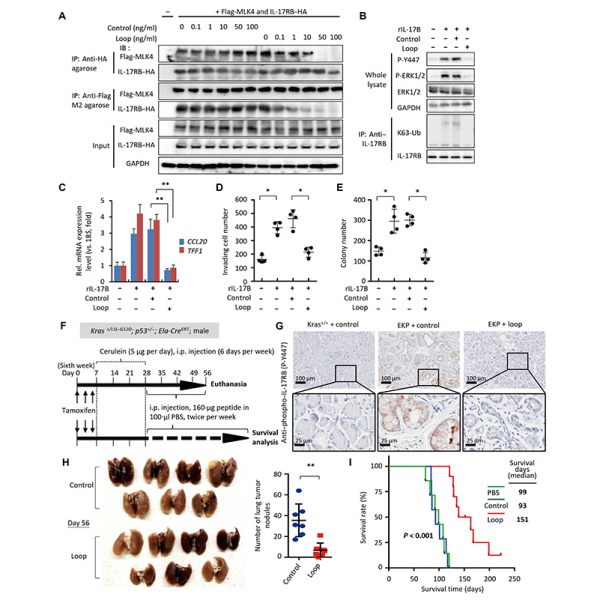The members of the interleukin-17 (IL-17) cytokine family and their receptors were identified decades ago. Unlike IL-17 receptor A (IL-17RA), which heterodimerizes with IL-17RB, IL-17RC, and IL-17RD and mediates proinflammatory gene expression, IL-17RB plays a distinct role in promoting tumor growth and metastasis upon stimulation with IL-17B. However, the molecular basis by which IL-17RB promotes oncogenesis is unknown. Here, we report that IL-17RB forms a homodimer and recruits mixed-lineage kinase 4 (MLK4), a dual kinase, to phosphorylate it at tyrosine-447 upon treatment with IL-17B in vitro. Higher amounts of phosphorylated IL-17RB in tumor specimens obtained from patients with pancreatic cancer correlated with worse prognosis. Phosphorylated IL-17RB recruits the ubiquitin ligase tripartite motif containing 56 to add lysine-63–linked ubiquitin chains to lysine-470 of IL-17RB, which further assembles NF-κB activator 1 (ACT1) and other factors to propagate downstream oncogenic signaling. Consequentially, IL-17RB mutants with substitution at either tyrosine-447 or lysine-470 lose their oncogenic activity. Treatment with a peptide consisting of amino acids 403 to 416 of IL-17RB blocks MLK4 binding, tyrosine-477 phosphorylation, and lysine-470 ubiquitination in vivo, thereby inhibiting tumorigenesis and metastasis and prolonging the life span of mice bearing pancreatic tumors. These results establish a clear pathway of how proximal signaling of IL-17RB occurs and provides insight into how this pathway provides a therapeutic target for pancreatic cancer.
語言
Wednesday, 03 March 2021 17:20
